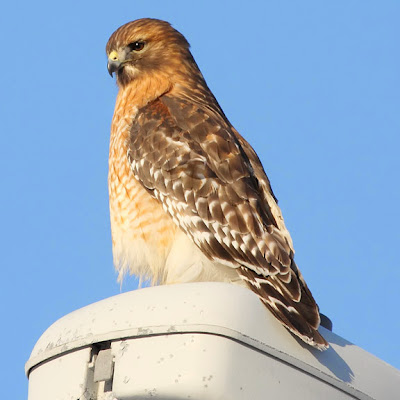There are five different subspecies of red-shouldered hawks. The subspecies with the largest range is the lineatus subspecies. Often called the northern red-shouldered they are found from Kansas to the Atlantic Coast, in the south, up to southern Canada. These red-shouldered hawks are larger in size then the other subspecies. The top photo is a northern red-shouldered hawk photographed in Minnesota. There are 2 subspecies in Florida, alleni and extimus. the extimus subspecies is found only in the southern parts of Florida. The Florida subspecies are smaller and usually lighter in color especially around the face. The bird in the photo above was photographed in Florida. The last eastern subspecies is texamus and they are found in eastern Texas and northeastern Mexico. There is one subspecies, elegans, found along the Pacific coast mostly in California. Their breast and belly are more orange and have less barring then the other subspecies. This subspecies used to be called the red-bellied hawk.
Red-shouldered hawks breed once per year, typically between April and July. They often sue the same nest year after year with both male and female helping to refurbish it. The average clutch size is three to four eggs which are usually laid with in two to three days. The eggs are incubated for a little over a month before they hatch. It is around six weeks before the chicks are ready to fly. After they fledge the young will hang around for another three to four months before they will leave their parents territory to find a place of their own. This last photo shows the different coloration of an immature Florida red-shouldered hawk. Saturday, September 21, 2013
Red-shouldered Hawk
The red-shouldered hawk is a medium sized hawk that is typically found in the eastern half of the United States and along the Pacific coast in California. They are forest hawks that typically ambush their prey, located on the forest floor, from a perch in the trees. Their main prey is small rodents, such as mice, voles, rats, moles, chipmunks, and ground squirrels. They will also take other prey such as tree squirrels, rabbits, reptiles, amphibians, birds and larger bugs, when available. They stay on territory all year long through out most of their range, with only the birds in the farthest north regions migrating to central Mexico for the winter.
Subscribe to:
Post Comments (Atom)






8 comments:
Fantastic shots and great information.
Post is full of information and great photos
Post is full of information and great photos
That hawk looks to be up to serious business. I always enjoy reading information you include. Each post is a mini science lesson for me. genie
Absolutely stunning!!!!!
Very interesting! Growing up in northern New Jersey I never saw a Red-shouldered Hawk. There are plenty of them here in Florida. Interestingly, the Blue Jays here can imitate their calls almost perfectly. I never heard that call from Jays in New Jersey and I guess they never did either!
A bird that looks like a "no nonsense" character. Beautiful, defined markings on the feathers.
beautiful shots of a beautiful bird. :) Thanks for sharing the info.
Post a Comment